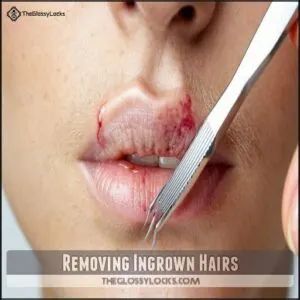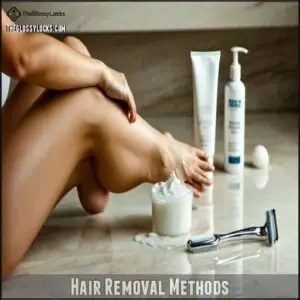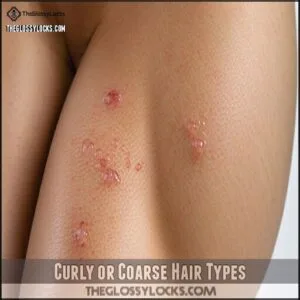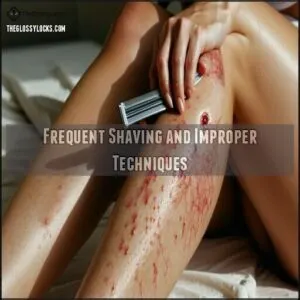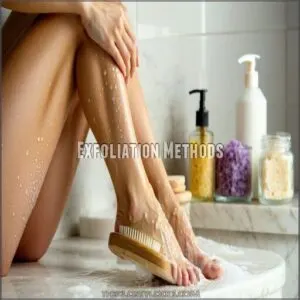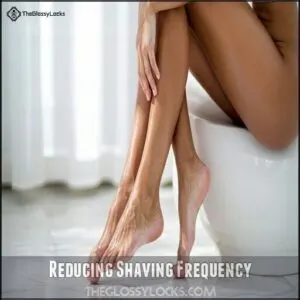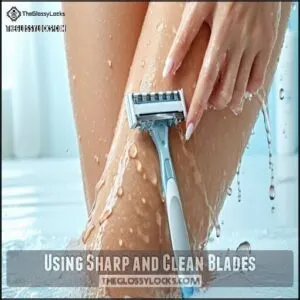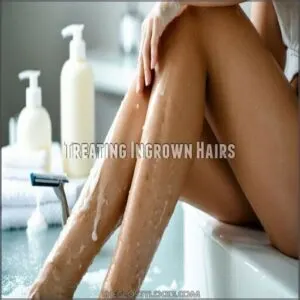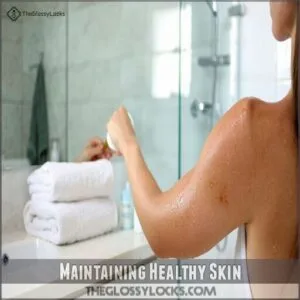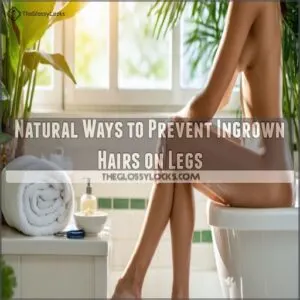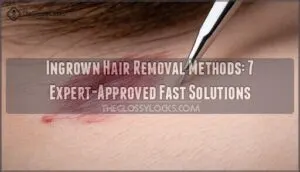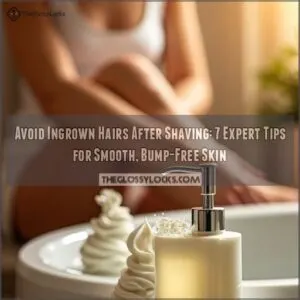This site is supported by our readers. We may earn a commission, at no cost to you, if you purchase through links.
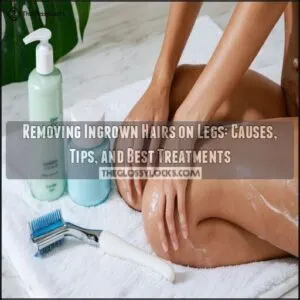
Gently exfoliate with a scrub or exfoliating glove to free trapped hairs, but don’t overdo it—your skin’s not a scratch-off ticket! Use a warm compress to soften the area, making it easier for the hair to surface.
If shaving caused the problem, switch to a sharp, clean blade and shave in the direction of hair growth.
For stubborn spots, try an over-the-counter treatment with salicylic acid or aloe. Stay consistent with moisturizing and wear loose clothing to prevent future irritation.
Curious about the best products to help? Keep reading!
Table Of Contents
- Key Takeaways
- Removing Ingrown Hairs
- Causes of Ingrown Hairs
- Preventing Ingrown Hairs
- 8 Best Products for Ingrown Hairs
- 1. Cortizone 10 Anti-Itch Cream Aloe
- 2. Aquaphor Maximum Strength Itch Relief
- 3. Aveeno Anti-Itch Cream Maximum Strength
- 4. Softsoap Coconut Body Scrub Wash
- 5. Natural Loofah Exfoliating Body Scrubber
- 6. Salmon Beige Exfoliating Kessa Glove
- 7. First Aid Beauty KP Bump Eraser
- 8. AmLactin Daily Nourish Dry Skin Lotion
- Treating Ingrown Hairs
- Maintaining Healthy Skin
- Frequently Asked Questions (FAQs)
- Conclusion
Key Takeaways
- Exfoliate gently with a scrub or exfoliating gloves to free trapped hairs and prevent new ones from forming.
- Use a sharp, clean razor and shave in the direction of hair growth to reduce irritation and ingrown hairs.
- Apply warm compresses to soothe the area and over-the-counter treatments like salicylic acid or aloe to target stubborn spots.
- Moisturize daily and wear loose, breathable clothing to keep your skin hydrated and prevent future irritation.
Removing Ingrown Hairs
Removing ingrown hairs safely is all about using the right techniques to free the trapped hairs and soothe your skin.
Free your skin from the irritation of ingrown hairs with gentle care, proper tools, and a little extra attention.
By combining exfoliation, proper tools, and gentle care, you can minimize discomfort and reduce the risk of future ingrown hairs.
Understanding Ingrown Hair Causes
Ingrown hairs on legs happen when hair grows back into the skin instead of out.
Common ingrown hair causes include:
- Hair removal methods like shaving or waxing.
- Curly hair that naturally re-enters the skin.
- Friction factors, such as tight clothing.
- Follicle shape, especially with coarse hair.
Understanding your skin type helps prevent these pesky bumps, and recognizing the role of hair removal methods is crucial.
Identifying Ingrown Hair Symptoms
Spotting leg ingrown hairs involves noticing small red bumps that might itch or hurt, known as the "Itchiness Factor" and "Pain Assessment."
Small red bumps on legs that itch or hurt signal ingrown hairs—manage them early to keep irritation under control.
These bumps often come with redness and inflammation.
Identifying these symptoms early helps you manage skin irritation before it worsens, keeping things under control, and addressing blister appearances or darker skin around the area are also common signs, which can be summarized as part of the overall skin irritation.
Causes of Ingrown Hairs
Ingrown hairs on your legs often happen when hair curls back or grows sideways into the skin instead of growing out.
This typically results from shaving, waxing, or other hair removal techniques that irritate the follicles or create sharp hair edges.
Hair Removal Methods
Hair removal methods play a big role in leg ingrown hairs. Shaving, waxing, tweezing, or depilatory creams can all influence growth patterns.
Some techniques, like shaving, create sharp tips, making ingrown hair removal tricky. Waxing benefits include smoother skin but might irritate follicles.
Regular exfoliation can help prevent them.
To minimize problems:
- Shave with proper technique and sharp razors.
- Use depilatory creams for gentler options.
- Avoid over-tweezing!
This approach can help manage ingrown hairs effectively, ensuring smoother skin.
Curly or Coarse Hair Types
Curly or coarse hair increases the risk of ingrown hairs due to its unique curl patterns and follicle shape, which can trap hair under the skin.
Genetic predispositions also affect the severity. Consider exfoliating ingrown hairs using specific products or opting for gentle leg hair removal techniques.
Proper ingrown hair treatment helps minimize discomfort and promote healthy skin.
| Factors | Effect on Ingrown Hairs | Suggested Action |
|---|---|---|
| Hair Curl Patterns | Higher curling risk | Exfoliate regularly |
| Follicle Shape | Traps growing hair | Use specific exfoliating products |
| Genetic Predisposition | Increased severity | Daily preventative care |
| Coarse Hair Type | Harder removal | Employ targeted ingrown hair removal |
Frequent Shaving and Improper Techniques
Rushing leg hair removal often leads to shaving ingrown hairs.
Shaving against the hair’s natural growth or stretching the skin creates sharp edges that dig into pores.
Dull razors tug, leaving rough cuts behind, while skipping blade rinsing clogs and irritates.
Try reducing shaving frequency and use proper shaving techniques to keep skin smooth and free from those stubborn red bumps, which can be prevented by avoiding actions that lead to ingrown hairs.
Preventing Ingrown Hairs
Preventing ingrown hairs starts with simple changes to your routine, like exfoliating regularly and shaving less often.
By using sharp, clean blades and following proper techniques, you can minimize irritation and keep your skin smooth.
Exfoliation Methods
Removing dead skin cells through physical or chemical exfoliation keeps ingrown hairs at bay.
Use exfoliation tools like a body scrub or a dry brush, working in circular motions.
Chemical exfoliators—like glycolic or salicylic acid—help sensitive skin by gently lifting trapped hairs.
Consider different types available for your skin.
Adjust your exfoliation frequency to match your skin type, avoiding irritation while promoting smooth, healthy legs, which is key to achieving healthy legs.
Reducing Shaving Frequency
Sometimes, shaving every day isn’t worth the hassle—or the ingrown hairs.
Spacing out your leg shaving lets hair grow naturally within its cycle, reducing irritation.
Explore alternative methods like waxing or depilatory creams for smoother results.
Fewer shaves mean less stubble management and better skin tolerance, which can help prevent hair removal woes and foster healthier regrowth. Give your skin a break to achieve this.
Using Sharp and Clean Blades
Keeping your razor in top shape makes leg shaving smoother and reduces ingrown hairs.
Dull blades cause skin irritation, so sharpen your technique with these tips:
- Use sharp razor blades for fewer passes.
- Stick to single or two-blade razor types.
- Clean blades with alcohol to kill bacteria.
- Shave at the proper shaving angle.
- Replace razors regularly to avoid nicks.
8 Best Products for Ingrown Hairs
Choosing the right products can make managing and preventing ingrown hairs much easier. Here are eight highly recommended options to keep your skin smooth and irritation-free.
1. Cortizone 10 Anti-Itch Cream Aloe
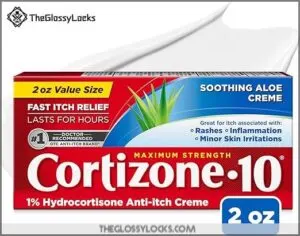
Packed with soothing aloe, Cortizone 10 Anti-Itch Cream offers quick relief for irritated, itchy skin caused by ingrown hairs.
Containing 1% hydrocortisone, this cream calms inflammation and reduces discomfort within minutes.
It’s fragrance-free and dye-free, making it ideal for sensitive skin. The non-greasy formula feels light and smooth, absorbing without leaving residue.
With its convenient, travel-friendly size, you can easily carry it wherever you go. Just a small dab goes a long way, ensuring relief lasts for hours. A must-have!
Best For: Those with sensitive skin seeking quick, non-greasy relief from itching, inflammation, and irritation caused by conditions like eczema, bug bites, or ingrown hairs.
- Fast-acting relief that lasts for hours.
- Fragrance-free and suitable for sensitive skin.
- Small, travel-friendly size for on-the-go use.
- Only provides temporary relief, requiring reapplication.
- May not be effective for severe skin conditions.
- Can be less effective on very dry or cracked skin.
2. Aquaphor Maximum Strength Itch Relief
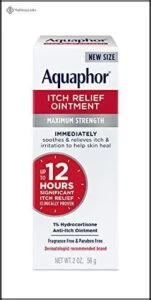
Aquaphor Maximum Strength Itch Relief is your go-to savior for irritation caused by ingrown hairs.
With 1% hydrocortisone, it calms redness, itchiness, and inflammation like a champ.
This fragrance-free, hypoallergenic ointment works wonders on sensitive or inflamed skin, offering up to 12 hours of relief.
Note that some users experience skin irritation and reactions, so perform a patch test first.
Simply apply a thin layer up to four times daily to soothe discomfort and promote healing. Gentle yet effective, it’s perfect for ingrown hair-prone areas, leaving your skin hydrated and on the mend without irritation.
Best For: Those with sensitive or inflamed skin seeking maximum strength itch relief from conditions like ingrown hairs, dry skin, insect bites, or rashes.
- Provides long-lasting itch relief for up to 12 hours.
- Contains dermatologist-recommended 1% hydrocortisone for effective soothing.
- Fragrance-free and hypoallergenic, ideal for sensitive skin.
- May leave an oily residue on the skin.
- Some users report the application is not easy due to thick consistency.
- Not suitable for use on open wounds.
3. Aveeno Anti-Itch Cream Maximum Strength
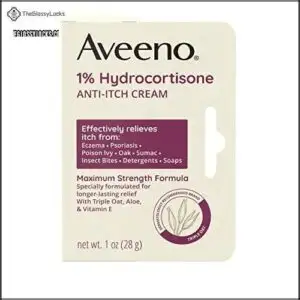
Aveeno Anti-Itch Cream Maximum Strength is your go-to for quick relief from itchy, irritated skin caused by ingrown hairs.
Featuring 1% hydrocortisone, it soothes the skin while the Triple Oat, Aloe, and Vitamin E formula keeps it nourished.
This fragrance-free, non-comedogenic cream suits all skin types, even sensitive areas.
It works fast to reduce redness and discomfort, leaving your legs feeling smooth and calm, with a lightweight, non-greasy texture that absorbs quickly.
Its formula makes it ideal for daily use on irritated skin.
Best For: People with sensitive skin looking for quick relief from itching caused by minor irritations like eczema, insect bites, or ingrown hairs.
- Fragrance-free and non-greasy formula suitable for all skin types.
- Soothes and nourishes skin with Triple Oat, Aloe, and Vitamin E.
- Provides fast and reliable relief, often noticeable within minutes.
- Not intended for long-term use without professional advice.
- May not be effective for severe or chronic skin conditions.
- Requires reapplication as it provides temporary relief only.
4. Softsoap Coconut Body Scrub Wash
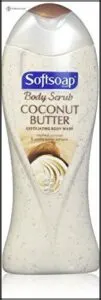
Softsoap Coconut Body Scrub Wash offers a tropical escape while tackling ingrown hairs.
Its crushed coconut extracts and jojoba butter gently exfoliate, removing dead skin that can trap hairs. The exfoliating beads leave your legs silky smooth, helping prevent future issues.
Dermatologist-tested and pH-balanced, it’s safe for sensitive skin and free of parabens and phthalates.
Use it during your shower routine to cleanse and moisturize, leaving a soothing scent. Pair it with other aftercare techniques for improved results and healthier skin.
Best For: Those seeking a gentle exfoliating body wash that leaves skin silky smooth while preventing ingrown hairs.
- Contains natural ingredients like crushed coconut and jojoba butter for effective exfoliation.
- Dermatologist tested, pH-balanced, and free of parabens and phthalates, suitable for sensitive skin.
- Luxurious tropical scent that enhances the shower experience.
- Some users might find the price slightly high compared to other body washes.
- Exfoliating beads may not be ideal for daily use on extremely delicate skin.
- The 15-ounce bottle may run out quickly with frequent use.
5. Natural Loofah Exfoliating Body Scrubber
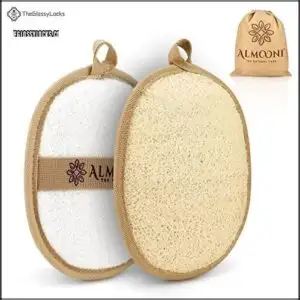
The Natural Loofah Exfoliating Body Scrubber is a game-changer for tackling ingrown hairs.
Its dual-sided design features a natural loofah for exfoliating dead skin and a terry cloth side for gentle cleansing.
By removing buildup and unclogging pores, it helps your skin breathe and prevents hairs from growing inward.
The hand strap makes it easy to maneuver, so you can target tricky areas.
Lightweight and eco-friendly, it’s a thoughtful addition to your skincare routine, perfect for smoother, refreshed legs.
Best For: People looking for an eco-friendly exfoliating scrubber to help reduce ingrown hairs and maintain smoother skin.
- Dual-sided design for exfoliation and gentle cleansing.
- Includes a hand strap for easier maneuverability.
- Made from natural, biodegradable materials.
- Natural loofah side may be too rough for sensitive skin.
- Initial shedding of loofah fibers reported by some users.
- Strap placement can be inconvenient when using the terry cloth side.
6. Salmon Beige Exfoliating Kessa Glove
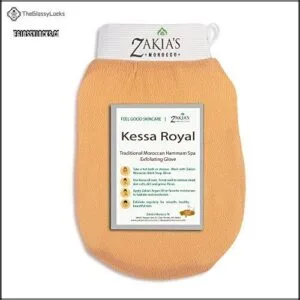
The Salmon Beige Exfoliating Kessa Glove is a game-changer for tackling ingrown hairs.
Made from 100% Viscose Crepe fabric, it effectively removes dead skin, dirt, and grime, helping unclog pores and prevent hair from curling inward.
Perfect for sensitive skin or issues like Keratosis Pilaris, it promotes skin elasticity and stimulates circulation.
Use it on damp skin with gentle, circular motions, and follow up with a deep moisturizer to keep your legs smooth and ingrown-free.
Proper care guarantees it lasts up to 12 months—keeping your legs smooth and ingrown-free.
Best For: Individuals with sensitive skin, Keratosis Pilaris, or those looking to prevent ingrown hairs and improve overall skin texture.
- Effectively removes dead skin and unclogs pores.
- Stimulates circulation and promotes skin elasticity.
- Long-lasting with proper care, up to 12 months of use.
- Texture may feel rough for some users.
- Requires proper technique to avoid skin irritation.
- Not suitable for use with exfoliating scrubs that may harm plumbing.
7. First Aid Beauty KP Bump Eraser
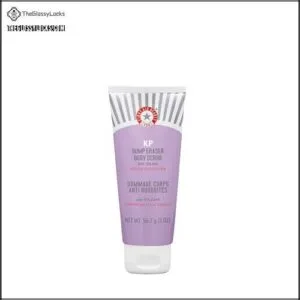
In the case of tackling pesky ingrown hairs, First Aid Beauty KP Bump Eraser is a game-changer.
With a potent 10% blend of glycolic and lactic acids, it exfoliates both chemically and physically, smoothing rough patches and reducing discoloration.
The fragrance-free formula is dermatologist-tested, vegan, and gentle enough even for sensitive skin.
For best results, massage it onto wet skin, rinse thoroughly, and follow up with a moisturizer to reveal softer, healthier skin you’ll love to show off, thanks to regular use.
Best For: People with keratosis pilaris or rough, bumpy skin looking for a gentle yet effective exfoliator.
- Combines chemical and physical exfoliation for smoother skin.
- Fragrance-free, vegan, and dermatologist-tested for sensitive skin.
- Noticeable improvement in skin texture with regular use.
- Can cause dryness if not followed with a moisturizer.
- Potential sun sensitivity due to AHA content.
- Price has increased, raising affordability concerns.
8. AmLactin Daily Nourish Dry Skin Lotion
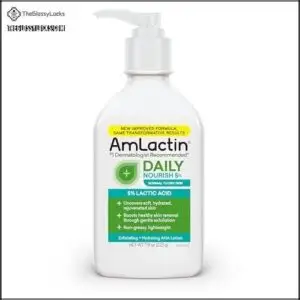
AmLactin Daily Nourish Dry Skin Lotion is your go-to for smoother, bump-free skin.
With 12% lactic acid, it gently exfoliates while hydrating, making it perfect for tackling stubborn ingrown hairs on legs.
Paraben-free and fragrance-free, this dermatologist-recommended lotion softens rough patches without irritation.
Its nongreasy formula absorbs quickly, leaving your legs smooth and polished.
Don’t forget sunscreen though—lactic acid can make your skin sun-sensitive.
For consistent results, apply daily and watch your skin transform, feeling soothed and moisturized in every application.
Best For: Individuals with dry, rough skin, keratosis pilaris, or ingrown hairs seeking gentle exfoliation and hydration.
- May increase sun sensitivity, requiring diligent sunscreen use.
- Some users may dislike the mild scent resembling maple syrup or soy sauce.
- Not ideal for those with oily skin due to its moisturizing formula.
- Contains 12% lactic acid for effective exfoliation and hydration.
- Lightweight, nongreasy, and quickly absorbs into the skin.
- Fragrance-free and paraben-free, suitable for sensitive skin.
Treating Ingrown Hairs
Treating ingrown hairs starts with soothing the skin and addressing irritation to prevent further discomfort.
By using simple techniques like applying warm compresses, moisturizing with aftershave creams, and practicing proper shaving methods, you can help your skin heal and reduce future occurrences, which is crucial for overall skin health and preventing further discomfort.
Applying Warm Compresses
A warm compress soothes ingrown hairs on legs by reducing redness and inflammation.
Use a clean cloth soaked in warm (not hot) water as your compress material. Apply it for 5-10 minutes, ensuring consistent compress temperature.
Repeat twice daily for best results.
Afterward, practice post-compress care by gently moisturizing to keep the skin soft and prevent irritation.
Using Aftershave Creams
Using aftershave creams is a simple way to soothe irritated, sensitive skin while preventing ingrown hairs after shaving or hair removal.
Opt for alcohol-free options with ingredients like aloe vera or tea tree oil for hydration and ingrown prevention. Some users also explore options for ingrown hair solutions to further alleviate discomfort.
Apply a thin layer to clean, dry leg skin for smooth results. Regular use improves overall leg skin care and helps in ingrown prevention.
Practicing Good Shaving Techniques
For smooth, bump-free legs, perfect your shaving routine. Start with proper skin preparation: exfoliate gently and hydrate the skin.
Use sharp razor blades and shave in the hair growth direction. Reduce shaving frequency to prevent irritation.
Focus on razor maintenance—clean and dry blades after use.
To prevent ingrown hairs, consider exfoliating skin regularly.
Maintaining Healthy Skin
Keeping your skin healthy is key to preventing stubborn ingrown hairs and irritation.
By moisturizing regularly, avoiding over-exfoliation, and choosing breathable clothing, you can create the perfect environment for smooth, irritation-free skin, which is essential for maintaining healthy skin.
Moisturizing and Hydrating
Hydration keeps your legs smooth, happy, and free from pesky ingrown hairs. After exfoliation or waxing, apply moisturizers rich in hydrating ingredients like hyaluronic acid or aloe vera.
Shaving cream also helps lock in moisture while reducing friction. For ideal results, consider a quality hydrating option.
Here’s how to boost hydration:
- Use lotions with ceramides.
- Apply moisturizer post-shave.
- Opt for after-waxing care creams.
- Avoid drying soaps.
- Keep hydrated internally and use a quality hydrating option to maximize the benefits of hydration.
Avoiding Excessive Exfoliation
Over-exfoliating your legs can weaken your skin barrier and cause irritation, making ingrown hairs worse.
Pay attention to irritation signs, like redness or sensitivity, and adjust exfoliation frequency based on your skin’s needs.
| Exfoliation Type | Frequency | Product Strength |
|---|---|---|
| Physical Scrub | 1-2 times/week | Gentle |
| Chemical Exfoliation | Weekly | Low Concentration |
| Exfoliating Glove | Daily | Light Pressure |
| Adjustable Based on Skin | Individual Sensitivity | As Needed |
Wearing Loose-Fitting Clothing
After caring for your legs post-treatment, wearing loose-fitting clothes helps in preventing irritation and skin problems.
Fabrics that allow air circulation and reduce friction, like cotton, are perfect for minimizing ingrown hair risks.
Tight clothes can trap sweat and increase skin irritation, so choose breathable options for post-treatment comfort and healthier skin.
Give your legs the space they deserve, and adopt simple routines like this to promote effective skin habits, such as those found at effective skin habits.
Frequently Asked Questions (FAQs)
Can stress cause or worsen ingrown hairs?
Stress doesn’t directly cause ingrown hairs, but it can worsen them.
Stress weakens your immune system, slows skin healing, and triggers inflammation, making it harder for your skin to recover from factors that cause ingrown hairs.
Are certain fabrics more likely to irritate skin?
Yes, certain fabrics like synthetic blends or tight, rough materials can irritate your skin.
Stick to breathable, natural fabrics like cotton or bamboo to reduce friction and let your skin breathe comfortably throughout the day, which helps avoid irritation from rough materials.
How do hormonal changes affect ingrown hairs?
What goes on inside reflects outside — hormonal changes, like during puberty, pregnancy, or menopause, can spike oil production and skin cell turnover.
This clogs follicles and increases the risk of ingrown hairs, especially in sensitive areas.
Does diet influence skin’s susceptibility to ingrown hairs?
What you eat impacts your skin.
A diet high in sugar or processed foods can inflame skin and clog follicles, increasing ingrown hairs.
Focus on fresh fruits, veggies, and hydration to support healthy skin.
Can specific medications increase ingrown hair risk?
Here’s the scoop: certain medications, like steroids or anti-inflammatory drugs, can sometimes mess with your skin’s natural shedding process, leading to clogged pores.
This increases the chances of pesky ingrown hairs popping up.
Conclusion
Taking care of your legs is like tending a garden—consistent care prevents problems like ingrown hairs.
By understanding the causes, symptoms, and solutions, you can tackle ingrown hairs effectively.
Exfoliate gently, keep your skin hydrated, and use a sharp blade when shaving.
Don’t forget to try helpful treatments like salicylic acid or aloe for stubborn areas.
With these tips, removing ingrown hairs on legs becomes manageable, leaving your skin smooth and irritation-free. Consistency is key!

